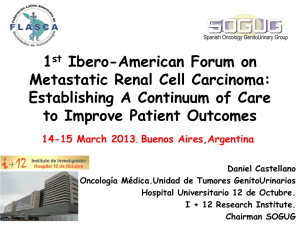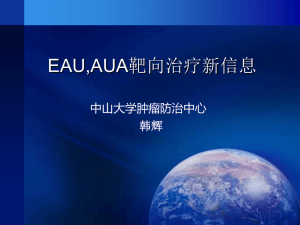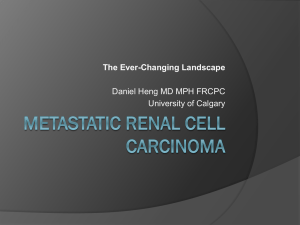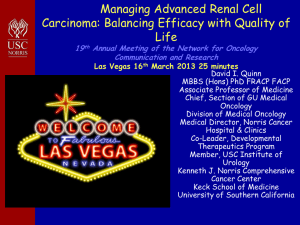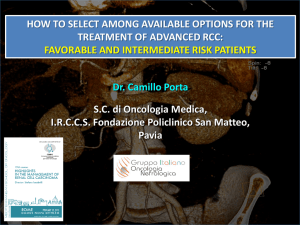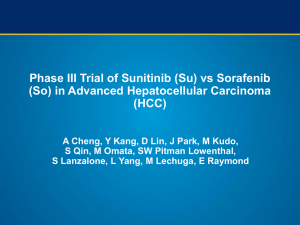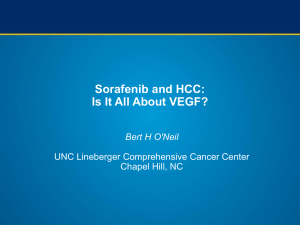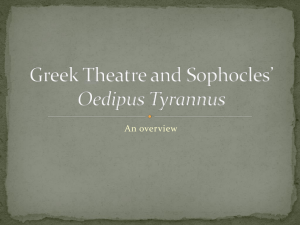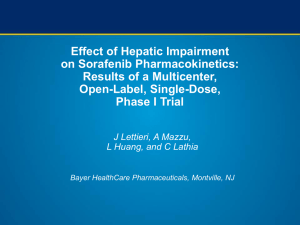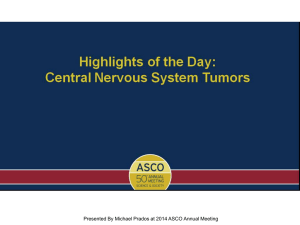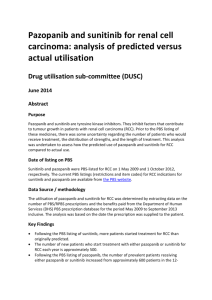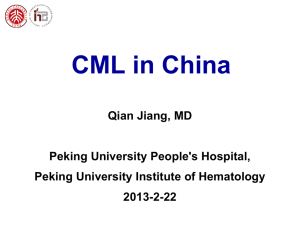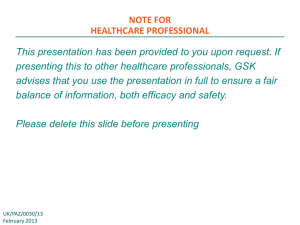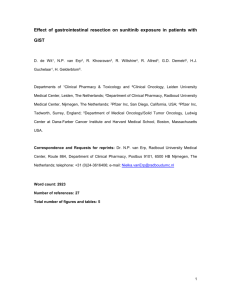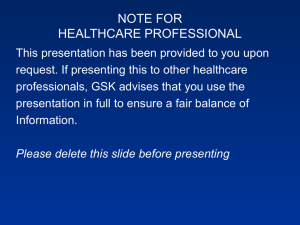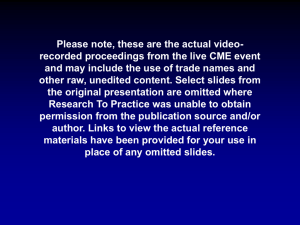FDA Evaluation of Hepatotoxicity Related to
advertisement
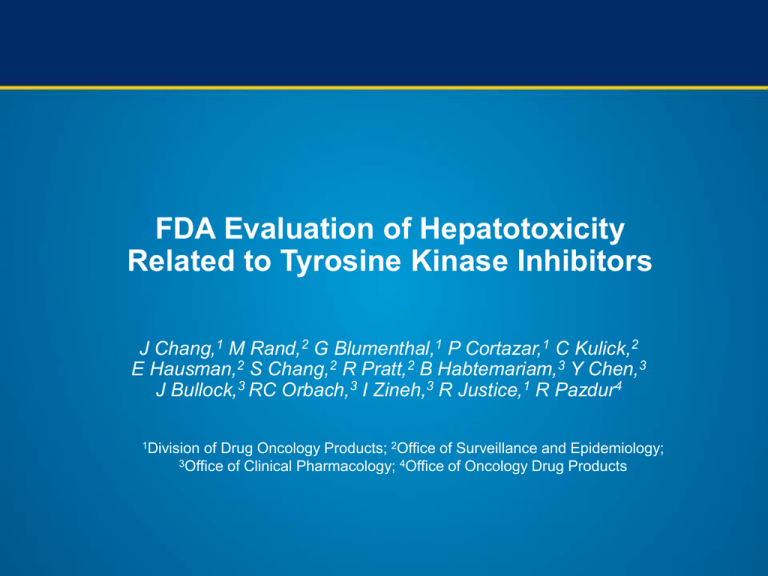
FDA Evaluation of Hepatotoxicity Related to Tyrosine Kinase Inhibitors J Chang,1 M Rand,2 G Blumenthal,1 P Cortazar,1 C Kulick,2 E Hausman,2 S Chang,2 R Pratt,2 B Habtemariam,3 Y Chen,3 J Bullock,3 RC Orbach,3 I Zineh,3 R Justice,1 R Pazdur4 1Division of Drug Oncology Products; 2Office of Surveillance and Epidemiology; 3Office of Clinical Pharmacology; 4Office of Oncology Drug Products Background Tyrosine kinase inhibitors (TKIs) interfere with several critical signal transduction pathways in cancer As of March 2010, FDA had approved 9 TKIs (imatinib, dasatinib, nilotinib, erlotinib, gefitinib, lapatinib, sorafenib, sunitinib, and pazopanib) to treat a variety of malignancies All TKIs are associated with severe liver injury (SLI) and have different categories for liver injury, ranging from boxed warnings for fatal hepatotoxicity to adverse reactions for elevated LFTs LFTs=liver function tests. Adapted from Chang J et al. Presented at: ASCO Annual Meeting; June 3-7, 2011; Chicago, IL. Methods Analyses included a literature review and an evaluation of postmarketing reports of SLI associated with TKIs from FDA’s Adverse Event Reporting System* (AERS) from various dates of marketing approval until March 15, 2010. SLI is defined as acute liver injury (elevated LFTs, bilirubinemia, or jaundice) in combination with 1 of the following events: death, liver transplantation or placement on liver transplant list, hepatic encepholopathy, coagulopathy, or renal impairment Drug utilization data were reviewed for comparison across TKIs. The estimated number of nationally projected dispensed prescriptions from mail order/specialty pharmacy and outpatient retail pharmacy settings was obtained from Wolters Kluwer Source PHAST Prescription Monthly™ from 2006 through 2009 For a mechanistic explanation, laboratory and exposure data were reviewed from 8 new drug application (NDA) submissions. Gefitinib data are excluded because it is no longer marketed in the United States. Exposure-response properties of TKI-induced liver enzyme and bilirubin elevations were evaluated * Limitations of AERS data include: underreporting, stimulated reporting, biased reporting, variable quality and content, and no certainty that the reported event is due to the product. Adapted from Chang J et al. Presented at: ASCO Annual Meeting; June 3-7, 2011; Chicago, IL. Results Literature search: As of April 2010, there were 19 case reports of liver injury with imatinib, 7 with erlotinib, 5 with sorafenib, 4 with sunitinib, and 2 with gefitinib. 15 of these reports were captured in AERS Drug utilization results: Total oral TKI market increased from approximately 313,000 prescriptions in 2006 to 348,000 prescriptions in 2009. Imatinib had the largest proportion of dispensed prescriptions Adapted from Chang J et al. Presented at: ASCO Annual Meeting; June 3-7, 2011; Chicago, IL. Results (cont’d) Total Number of Nationally Projected Dispensed Prescriptions for TKIs in US Mail-Order and Outpatient Retail Pharmacies, 2006-2009 FDA Approval Year Total Prescriptions 2006-2009, N Market Share 2006-2009, % Imatinib 2001 652,997 45.1 Erlotinib 2004 479,114 33.1 Sunitinib 2006 148,864 10.3 Lapatinib 2007 66,008 4.6 Dasatinib 2006 47,353 3.3 Gefitinib 2003 17,325 1.2 Sorafenib 2005 25,726 1.8 Nilotinib 2007 9,671 0.7 Pazopanib 2009 105 0 1,447,163 100 TKI TOTAL Source: Wolters Kluwer SOURCE PHAST Prescription, 2005-2009. Adapted from Chang J et al. Presented at: ASCO Annual Meeting; June 3-7, 2011; Chicago, IL. Postmarketing Cases Of the 497 cases evaluated for SLI, 55 were categorized as possibly or likely associated with a drug The majority of SLI cases were associated with sunitinib (22) and imatinib (13) Most common event terms were hepatic failure, hepatic necrosis, hepatic coma or encephalopathy, and hepatorenal failure 67% of postmarketing cases were from foreign sources, and 45% of cases involved patients enrolled in clinical trials No dasatinib cases were classified as possibly or likely associated with a drug Adapted from Chang J et al. Presented at: ASCO Annual Meeting; June 3-7, 2011; Chicago, IL. Postmarketing TKI Cases of SLI* Sunitinib n=22 Imatinib n=13 Gefitinib† n=7 Erlotinib n=6 Sorafenib n=2 Nilotinib n=2 Lapatinib n=1 Pazopanib n=2 Age (years) Median Range 64 45-83 50 4-78 72 48-88 67 53-77 56 56 38 22-53 54 54 29 21-37 Gender Male Female Unknown 14 8 1 10 3 4 3 3 3 1 2 0 0 1 0 2 RCC 16 GIST 2 Other 4 CML 8 GIST 3 Other 2 CML 1 GIST 1 Breast 1 Synovial sarcoma 2 Demographics Cancer type 1 NSCLC 6 Pancreatic 1 NSCLC 5 Other 1 Thyroid 1 RCC 1 * Limitations of AERS data include: underreporting, stimulated reporting, biased reporting, variable quality and content, and no certainty that the reported event is due to the product. † Gefitinib is no longer marketed in the United States. CML=chronic myelogenous leukemia; GIST=gastrointestinal stromal tumor; NSCLC=non–small cell lung cancer; RCC=renal cell carcinoma. Adapted from Chang J et al. Presented at: ASCO Annual Meeting; June 3-7, 2011; Chicago, IL. Postmarketing TKI Cases of SLI* (cont’d) Sunitinib n=22 Imatinib n=13 Gefitinib† n=7 Erlotinib n=6 Sorafenib n=2 Nilotinib n=2 Lapatinib n=1 Pazopanib n=2 Reported Adverse Event and Event Characteristics 16 2 2 10‡ 1 0 4 0 1 5 0 0 1 0 1 2 0 0 1 0 0 2 0 0 0 2 1 1 0 2 1 0 0 0 0 0 0 0 0 0 Dose (mg) Median Range 50 25-50 400 200-400 250 None 150 100-150 800 None 800 None 1500 None 800 None Time to event (days) Median Range 27 7-314 150 8-312 22 4-180 28 12-71 68 56-80 63 6-120 126 126 45 34-55 Outcome Death Hospitalization Life-threatening Other 16 4 2 0 8 5 0 8 6 1 0 0 5 1 0 0 1 0 0 1 2 0 0 0 0 1 0 0 2 0 0 0 (+) dechallenge (+) rechallenge 5 0 1 0 0 2 1 0 1 0 0 0 1 0 0 0 Hepatic failure Hepatic necrosis Hepatic coma or encephalopathy Hepatorenal failure Other§ * Limitations of AERS data include: underreporting, stimulated reporting, biased reporting, variable quality and content, and no certainty that the reported event is due to the product. † Gefitinib is no longer marketed in the United States. ‡ 2 Patients required liver transplant. § Other includes: hepatitis fulminant (2), liver disorder (1), hepatitis (1), hepatic cirrhosis (1). Adapted from Chang J et al. Presented at: ASCO Annual Meeting; June 3-7, 2011; Chicago, IL. Pharmacogenomics This is being explored as a potential tool to understand the mechanistic basis of drug-induced liver injury (DILI) and manage its clinical risks Susceptibility to idiosycratic DILI is currently attributed to the complex interaction of multiple factors such as genetic, environmental, and drug-related factors Genetic susceptibility to DILI is mostly associated with variations in immune response and/or drug metabolism and transport genes Lapatinib-induced hepatotoxicity has recently been linked to a HLA allele HLA=human leukocyte antigen. Adapted from Chang J et al. Presented at: ASCO Annual Meeting; June 3-7, 2011; Chicago, IL. Examples of Genotypic Associations for DILI Drug Therapeutic Class HLA Allele Reference (PMID) Flucloxacillin Antibiotic HLA-B*5701 Daly et al. 2009 [19483685] Ximelagatran Thrombin inhibitor HLA-DRB1*07 and HLA-DQA1*02 Kindmark et al. 2008 [17505501] Lumiracoxib NSAID HLA-DQA1*0102 Singer et al. 2010 [20639878] Antineoplastic HLA-DQA1*0201 Spraggs et al. 2011 [21245432] Lapatinib NSAID=nonsteroidal anti-inflammatory drug; PMID=PubMed identifier. Adapted from Chang J et al. Presented at: ASCO Annual Meeting; June 3-7, 2011; Chicago, IL. Clinical Pharmacology Preliminary review of the data from NDA submissions suggests that TKIs inhibit bilirubin clearance. As shown below, sorafenib (sor), nilotinib (Nil), and pazopanib (pazo) exhibit concentration-dependent inhibition of the hepatic UGT1A1 enzyme in vitro. Inhibition of UGT1A1 is expected to increase total bilirubin in vivo. 100 % Inhibition 80 sor:estradiol sor:SN-38 Nil:bilirubin Nil:estradiol pazo:HFC 60 40 20 0 0.1 0.5 1.0 5.0 10.0 50.0 100.0 Drug Concentration (M) Adapted from Chang J et al. Presented at: ASCO Annual Meeting; June 3-7, 2011; Chicago, IL. Clinical Pharmacology (cont’d) Probability of ALT >3 x ULN With Increasing Pazopanib Concentrations Probability of bilirubin >2 x ULN With Increasing Pazopanib Concentrations 100 80 Logistic regression Observed proportion (95% CI) 80 Probability of ALT >3 x ULN (%) Probability of ALT >3 x ULN (%) Logistic regression Observed proportion (95% CI) 60 40 20 60 40 20 4/63 3/63 1/64 17/63 2/63 16/63 11/63 0 8/64 0 20 40 60 80 Steady State Trough Concentration (g/mL) With increasing trough concentrations of pazopanib, the probability of ALT >3 x ULN increases with increasing pazopanib plasma concentrations 0 0 20 40 60 80 Steady State Trough Concentration (g/mL) No concentration-dependent increase in total bilirubin >2 x ULN is observed ALT=alanine aminotransferese; CI=confidence interval; ULN=upper limit of normal. Adapted from Chang J et al. Presented at: ASCO Annual Meeting; June 3-7, 2011; Chicago, IL. Conclusions The pharmacogenomics data for lapatinib thus far suggest a genetic association for DILI. More research into the predictive value, sensitivity, and specificity of these biomarkers is needed to understand their clinical utility for predicting patients who are susceptible These associations may be used in the future to identify individuals at greater risk of developing liver injury Consideration of both genetic and nongenetic factors in DILI may help to identify these patients and improve therapy management. Investigations of the exposure response analysis for other TKIs are ongoing Review of postmarketing and clinical pharmacology data suggests a role for TKIs in causing hepatotoxicity. However, review of postmarketing AERS data* precludes class labeling for SLI for all TKIs Greater numbers of cases for imatinib and sunitinib may relate to greater national market share of TKIs * Limitations of AERS data include: underreporting, stimulated reporting, biased reporting, variable quality and content, and no certainty that the reported event is due to the product. Adapted from Chang J et al. Presented at: ASCO Annual Meeting; June 3-7, 2011; Chicago, IL. TKI Labeling for Hepatotoxicity Drug Boxed Warning Imatinib* Dasatinib Nilotinib Erlotinib Gefitinib† Lapatinib Sunitinib Warnings and Precautions Fatal Hepatotoxicity, Severe Liver Injury (requiring liver transplant), Acute Liver Failure, Elevated LFTs Elevated LFTs Hepatic Failure and Hepatorenal Syndrome (including fatalities) Elevated LFTs (Precautions section) Fatal Hepatotoxicity Fatal Hepatotoxicity Fatal Hepatotoxicity Fatal Hepatotoxicity Sorafenib* Pazopanib Fatal Hepatotoxicity Fatal Hepatotoxicity Adverse Reactions Additional Data From Clinical Trials or Postmarketing Experience Elevated LFTs Hepatitis, Hepatic Failure, and Hepatic Necrosis (including some fatalities) Elevated LFTs Elevated LFTs Hepatitis Hepatitis, Hepatotoxicity Elevated LFTs Hepatotoxicity Hepatotoxicity Drug-induced hepatitis, Liver Dysfunction including reports of hepatic failure and death Elevated LFTs Updated changes are in bold and italics * Imatinib and sorafenib prescribing information updated in italics. † Gefitinib is no longer marketed in the United States. Adapted from Chang J et al. Presented at: ASCO Annual Meeting; June 3-7, 2011; Chicago, IL.

